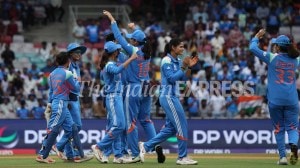The Maximum City has many Bombays within it. One such is Khotachiwadi, a 19th-century heritage precinct in Girgaon, popular for its Portuguese-influenced architecture and its diversity, that shows both in its buildings and through its people.
It is hard to miss Lynette Fernandez, 82, who spends her evenings on the porch of her century-old bungalow, chatting with passers-by. “We all grew up together. We would have these ‘pound parties’; no alcohol, just soft drinks. And each of us would bring something,” says Fernandez, as she points to the Girgaum Catholic Club that abuts her house. “There were many Catholic and Hindu families. We would exchange sweets on Diwali and Christmas,” she adds.

But like many others in the area, she finds herself in an existential battle as everything around this urban village is changing rapidly.
Story continues below this ad
Khotachiwadi, once part of a vast coconut plantation, stands out for its cobbled, narrow lanes, colourful single-storey bungalows, with sloping tiled roofs and wood-frame porches. The sounds of the city are left far behind, its streets dominated by pedestrians.
How the East Indian community evolved
Since the 19th-century, several communities, including the East Indians, Pathare Prabhus, and Panchkalshis have settled here. It was the association with the British East India Company (EIC) that lent the name to the indigenous community. “They never called themselves East Indians until around 140 years ago,” says Fleur D’Souza, former head of the History Department at St Xavier’s College.
Soon, in search of employment, other Christians from across the west coast began streaming in. The original inhabitants of Bombay banded together as the East Indians and demanded that the sons of the soil be differentiated from the others. “The East Indian community started off as a political community. The name ‘East Indian’ does not reflect geography but history, culture and community consciousness,” says D’Souza.
The East Indians trace their roots to different castes and occupational groups such as the Kunbis (agriculturists), Agris (working in salt pans), Kolis (fishermen), Bhandaris (toddy-tappers), Kumbhars (potters) and even the urban westernised elite, adds D’Souza.
Story continues below this ad
Conservation architect Pankaj Joshi, principal director, Urban Center Mumbai, explains that those close to the city, with stable jobs in the colonial administration, excelled.
Many East Indians grew to become well-known families of Bombay. For instance, Joseph ‘Kaka’ Baptista was the president of the Indian Home Rule League. He became the mayor of Bombay in 1925. Meanwhile, the younger generation began migrating. “In the last 40-50 years, almost every family has someone abroad and that leaves only senior residents in the locality,” says Joshi.
 The threat of redevelopment looms in Mumbai’s many gaothans (Credit: Pradip Das)
The threat of redevelopment looms in Mumbai’s many gaothans (Credit: Pradip Das)
In the real estate grip
Now with the shift in the city’s centre from the south to the west and east of Mumbai, areas like Khotachiwadi are soft targets for redevelopment.
Land revenue documents classify some of these urban villages as gaothans, which were taxed differently from the newer settlements. The term ‘gaothan’ was used to refer to the core of the village with settlements usually built on a higher ground.
Story continues below this ad
Scattered across Mumbai, the gaothans have become footnotes to the city’s Portuguese past. The East Indians are fighting hard to preserve their heritage under the shadow of gentrification and commercialisation. But not all development is bad – some welcome it, while others find it corrosive to the community.
At Matharpacady, some bungalows have already been converted into apartments. “We have tried our best to maintain the originality of our village,” says Julius Valladares, 65, a third-generation resident, “Our greatest fear is that politicians and builders will exploit the village commercially. There is talk about redevelopment, but we hope that the project will be shelved.”
In Bandra, gaothans like Ranwar and Pali have turned into commercial hubs. Pali bungalows hold a rustic charm of a gaothan yet one cannot but notice the names of salons, design firms, cafes and restaurants on plaques. This gentrification has also meant an increased anthropological interest in the community.
Nikhil Mahashur, an architect and restorer, who organises heritage walks, says, “The locals who want good rent allow these restaurants to crop up. It allows more people to know about the village. Awareness is important.”
Story continues below this ad
While gentrification, as one has seen in New Delhi’s Haus Khas Village and Shahpur Jat, may not be the answer, it is not uncommon for residents in these areas to feel the weekend hustle on the streets. For others, it’s about being in a neighbourhood where they no longer know the people next door.
André Baptista, archaeologist and historian, warns against the “gimmickisation of heritage.” For instance, the residents of Khotachiwadi, which has largely retained its heritage structures, have had tourists invade their private spaces. “The residents started feeling like they were in a zoo,” says Baptista.
In Vile Parle’s St Francis Pakhady, only traces of the original 200-year-old gaothan remain. Alphi D’Souza, the global head of the Mobai Gaothan Panchayat and a resident of Vakola village, says that there were once 189 gaothans in Mumbai. The figure is now roughly less than 100 as many have been absorbed into the city after redevelopment.
He adds that the phenomenon is “natural” because “families are growing and there’s no place”. “All bungalows are giving way to big buildings. But these houses cannot go over one floor. The Brihanmumbai Municipal Corporation (BMC) has a restriction on height,” he says.
Story continues below this ad
 Pali bungalows hold a rustic charm of a gaothan yet one cannot but notice the names of salons, design firms, cafes and restaurants on plaques (Credit: Pradip Das)
Pali bungalows hold a rustic charm of a gaothan yet one cannot but notice the names of salons, design firms, cafes and restaurants on plaques (Credit: Pradip Das)
Community at the centre
Gaothans have been stuck in legislative limbo for years now. The status of their heritage tag is debatable amid the many draft lists published by the state government over the years. The rules governing their development have also been contested.
Joshi flags a new rule in October last year that says gaothans can be considered under the provision of cluster redevelopment. “That is a major threat. We are saying let the community decide. We never asked for cluster development. We are not slums. We are the original indigenous communities of Maharashtra.”
This trapeze act of “preserving and un-preserving” is an urban conundrum across cities. In the preservation of gaothans, Baptista asks: “Are we just preserving the architecture and therefore just the shell of what exists? That is not really cultural preservation because without its vibrancy, the essence is lost.”
Joshi concurs that the choice should be with the residents. “You cannot club all of them under one provision. Some gaothans, where there is no pressure of development and they want to retain the heritage fabric, they should get to do that. Some gaothans can incrementally grow if they need. And those who desperately want redevelopment, should have that choice.”



 The threat of redevelopment looms in Mumbai’s many gaothans (Credit: Pradip Das)
The threat of redevelopment looms in Mumbai’s many gaothans (Credit: Pradip Das) Pali bungalows hold a rustic charm of a gaothan yet one cannot but notice the names of salons, design firms, cafes and restaurants on plaques (Credit: Pradip Das)
Pali bungalows hold a rustic charm of a gaothan yet one cannot but notice the names of salons, design firms, cafes and restaurants on plaques (Credit: Pradip Das)





























